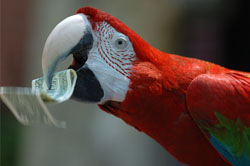It’s dollar time
Monday, July 12, 2010

Adopting the U.S. dollar would increase productivity in the region.
The euro has helped make Europe’s economy stronger. The dollar can help make Central America more productive.
Dollarization has always made sense in Central America, a region with too many currencies and not enough money.
Adopting a single currency is more important than ever, now that Central America is becoming a single economic zone, capable of attracting major international investors.
In recent years, some of Central America’s leading regional businesses have sold out to foreign multinationals, including HSBC, Citi, Scotiabank, Wal-Mart, SABMiller and InBev.
These and other companies want to take advantage of the region’s strategic geographic location, as well as its increasing political and economic stability.
But Central American companies would get more money for selling their assets (and Central America would be richer), if buyers no longer had to suffer exchange-rate losses, or waste valuable time planning exchange-rate strategies.
Also, a dollarized Central America would be more attractive to foreign investors, who tend to worry about monetary instability in small economies.
In this case, the four countries with local coinage – Guatemala, Honduras, Nicaragua and Costa Rica - should adopt the currency of Central America’s biggest trading partner and main source of investment (El Salvador and Panama are already dollarized).
Doing this will make the region more efficient, with not much downside.
The United States charges a fee for the right to use the dollar.
But this cost is modest.
In addition, the four countries would save money by no longer having to operate central banks.
In theory, abandoning national currencies means giving up control of monetary policy.
But globalization has already reduced the power of local central banks.
As a result, not much would change if they disappeared.
If the U.S. Federal Reserve were to raise interest rates at a time when this is inconvenient for Central America (for example, during a recession), local central banks would have to do the same, whether they liked it or not.
Otherwise, capital would flow out of the region.
Likewise, the Fed may want to ease credit at a time when Central America wants to limit its money supply.
But even if a monetary authority tried to raise local rates, many of the region’s bigger businesses and financial institutions could (and would) borrow cheap money in the United States and inject it into the economy.
One of the biggest concerns about a dollarized Central America is that it could face the same problems Argentina had when it pegged its currency to the dollar in the 1990s.
In that case, many Argentine exporters found themselves unable to compete with their counterparts in Brazil, whose currency - and therefore exports - kept getting cheaper.
Central America likewise competes with other countries in various sectors.
The region’s agricultural producers, however, are unlikely to reduce their output of major products, such as bananas, melon and pineapple.
Growers already own most or all of the land on which these crops are farmed, so dollarization would impose no additional real estate costs on them.
Wages could rise.
But salaries would have to go up significantly, before it becomes cheaper to lay off workers.
The region’s fastest-growing export sectors are tourism and recreational real estate, which face competition from Mexico and various Caribbean destinations.
But in deciding which country to visit or where to buy property, price is only one factor in a buyer’s decision, which also depends on geographic location, local culture, and the uniqueness of the product or service being offered.
Besides, various Caribbean economies are already dollarized.
Nor would a dollarized Central America be at a competitive disadvantage compared to Mexico, based on recent experience - the peso’s value fell by less than 3% versus the dollar during the past five years (and went up during the last 12 months).
The dollar is not an economic cure-all for Central America.
But for foreign investors – and eventually for all Central Americans - it’s stronger medicine than quetzales, córdobas, lempiras and colones.
Fred Blaser
Chairman
República Media Group
